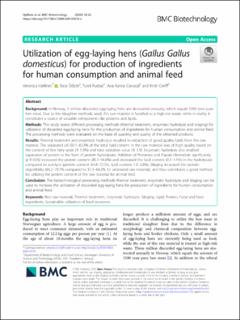| dc.contributor.author | Hjellnes, Veronica Hammer | |
| dc.contributor.author | Slizyte, Rasa | |
| dc.contributor.author | Rustad, Turid | |
| dc.contributor.author | Carvajal, Ana Karina | |
| dc.contributor.author | Greiff, Kirsti | |
| dc.date.accessioned | 2020-05-22T07:00:50Z | |
| dc.date.available | 2020-05-22T07:00:50Z | |
| dc.date.created | 2020-05-07T10:29:34Z | |
| dc.date.issued | 2020 | |
| dc.identifier.issn | 1472-6750 | |
| dc.identifier.uri | https://hdl.handle.net/11250/2655248 | |
| dc.description.abstract | Background
In Norway, 3 million discarded egg-laying hens are destructed annually, which equals 1500 tons pure hen meat. Due to the slaughter methods used, this raw material is handled as a high-risk waste, while in reality it constitutes a source of valuable components like proteins and lipids.
Methods
This study assess different processing methods (thermal treatment, enzymatic hydrolysis and silaging) for utilization of discarded egg-laying hens for the production of ingredients for human consumption and animal feed. The processing methods were evaluated on the basis of quantity and quality of the obtained products.
Results
Thermal treatment and enzymatic hydrolysis resulted in extraction of good quality lipids from the raw material. The separated oil (50.1–82.3% of the total lipid content in the raw material) was of high quality based on the content of free fatty acids (≤ 1.0%) and total oxidation value (≤ 3.9). Enzymatic hydrolysis also enabled separation of protein in the form of protein hydrolysate. Addition of Protamex and Papain+Bromelain significantly (p ≤ 0.05) increased the protein content (85.1–94.6%) and decreased the lipid content (0.3–1.1%) in the hydrolysate compared to autolysis (protein content: 64.8–72.3%, lipid content: 1.0–2.6%). Silaging increased the protein digestibility (63.2–79.7% compared to 57.3–66.2% for untreated raw material), and thus constitutes a good method for utilizing the protein content of the raw material for animal feed.
Conclusion
The biotechnological processing methods thermal treatment, enzymatic hydrolysis and silaging can be used to increase the utilization of discarded egg-laying hens for production of ingredients for human consumption and animal feed. | en_US |
| dc.language.iso | eng | en_US |
| dc.publisher | BMC (part of Springer Nature) | en_US |
| dc.relation.uri | https://rdcu.be/b30Ij | |
| dc.rights | Navngivelse 4.0 Internasjonal | * |
| dc.rights.uri | http://creativecommons.org/licenses/by/4.0/deed.no | * |
| dc.title | Utilization of egg-laying hens (Gallus Gallus domesticus) for production of ingredients for human consumption and animal feed | en_US |
| dc.type | Journal article | en_US |
| dc.type | Peer reviewed | en_US |
| dc.description.version | publishedVersion | en_US |
| dc.source.volume | 20 | en_US |
| dc.source.journal | BMC Biotechnology | en_US |
| dc.source.issue | 22 | en_US |
| dc.identifier.doi | 10.1186/s12896-020-00618-x | |
| dc.identifier.cristin | 1809746 | |
| dc.description.localcode | © The Author(s). 2020 Open Access This article is licensed under a Creative Commons Attribution 4.0 International License. | en_US |
| cristin.ispublished | true | |
| cristin.fulltext | original | |
| cristin.qualitycode | 1 | |

